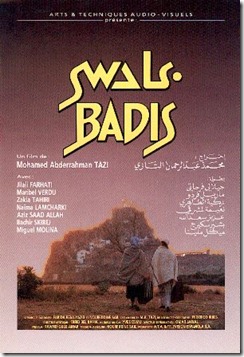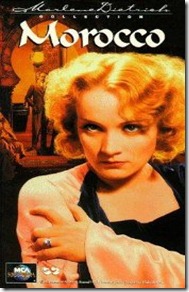Badis (1989) is a Moroccan film by the Moroccan filmmaker Mohamed Abderrahman Tazi. This film must have been of a great influence broadly for it had “great critical success, both locally and internationally, winning prizes or special mentions at festivals in Amiens, Montreal, Locarno, Milan, Carthage, and Meknes, among others. Tazi also had a number of stimulating experiences showing the film abroad.”[1] The film is co-produced with a Spanish television that helped in its finances. It is worth mentioning here that Tazi is married to a Spanish wife, and he was living in Spain for certain period where he got his education. Thus, to some extent the film does mirror some of Tazi’s life.
Surprisingly, and despite of the great success, Badis when released in Morocco got “close[d] after one week, drawing a total of barely three hundred spectators.”[2] It is then when the director Tazi “proposed to Spanish television (TVE) that it ‘co-produce’ the film.”[3] This means that the film, Badis, has certainly been shaped by the Spanish television’s opinion to serve a particular interest. Tazi, however, claims that nothing was changed, neither added nor removed, even a comma from the screenplay.[4]
The title “Badis” is the name of an actual village in the regions of al-Hocima. Obviously, the setting is not arbitrarily chosen; it is a village in the north of which the fort has been occupied by Spain. Tazi, however, claims that the reason behind this choice is that he simply felt in love with the place. I think it is far more than that; the village has a rich history, and it is that history that Tazi is trying to bring to the surface. There is one single setting; this means that the setting itself is of a great importance to the film, besides being the title of the film.
The opening scene gives a general view of the village with the camera moving from left to right, and the call of prayer in the background. It familiarizes the viewer with the setting of the film; it gives the impression that this tiny village is a world of men, while women are hiding within their domesticated spheres. In this atmosphere where we are introduced to the first character in the film; Moira dancing flamenco, Spanish dance. Moira eventually falls in love with the Spanish soldier who everyday goes to the village for water. Meanwhile, a school teacher moves to the village with his wife, Touria. The latter was going loose in Casablanca, and as a form of discipline, her husband brings her to the tiny village where she will be under his supervision, while throughout the film we witness that he is the one under her gaze.
Women are a complex issue, the role of women is problematized. The female characters appear to be revolutionists; Moira monopolizes her domesticated sphere to dance while the man (her father) is not there. Touria feels more comfortable when the man (her husband) is not there. The owner of the café (woman) is running loose and having an affair with the postman while her husband is abroad.
The movie is very complex in terms of its explicit themes: patriarchy, mixed-marriage, etc, as well as the implicit ones that of the journey towards the colony. Touria and Moira were seeking refuge towards the colonizer, which is, obviously, the destination of their escape. They were heading to the arms of the colonizer, running from a patriarchal prison to a military one, knowing that the fort was used as a prison as Tazi states that “up until 1976 it was a prison for opponents of Franco.” They will be imprisoned, and might be even used as sex objects in another kind of men’s world. There “escape” or journey towards the colonizer is soon interrupted by the native men.
Another important feature of the film is that all actors are central, though the story might seem to revolve around certain characters. Every individual has a central function, the teacher and his wife, Ba Abdellah and his half-Spanish daughter Moira, the all-seeing postman and his mistress the café owner. Tazi explains that “each character is rather linear and has his or her own particular story. The cafe´ owner is thinking about building a tourist hotel with the money her husband sends from abroad, the postman is looking forward to a transfer, the teacher is trying to punish his wife, the fisherman wants to keep his half-Spanish daughter on the straight and narrow. Within the setting that brings them together, each has a line to follow.”[5]
Importantly, the postman knows everything; he is the one in charge of all the private letters and the news of the whole village. Through him we have an insight into the film. He appears to be manipulative and a source of troubles. In the end of the film, he leaves the village, which he used to always call “the hole,” because he was transferred to a big city.
The final scene is very symbolic, after Moira and Touria are caught by the fishermen while attempting to escape, they are brought back to the village and eventually encircled by the men of the village. Moira starts to exhibit her body as if telling the men staring at her “here is the body that you have longed for.” All of a sudden a woman appears in the crowd and, paradoxically, throws the first stone on the women within the circle, and then followed by the others. The two women are stoned till death, this has a religious dimension of what is called in Islam the hudud[6] that a woman should be stoned till death if she is betraying her husband. The camera shows two lifeless bodies lying on the ground with a white wall in the background. Tazi explains that “it was not to kill that the old woman did this, but to stop the spectacle. Women are the guardians of tradition; the men were shocked, mesmerized, so the woman in a sense acted to protect the young women.”[7] It could also be explained that the woman is punishing them for going to the colonizers to prostitute themselves. Interestingly, the teacher, even after the women’s death, is still stoning the circle-like place where women were stoned, which could be interpreted as stoning the Satan that had embodied the two women.
The director gives no room to another ending; he believes that this is the tragic end that fits the film. According to the film, women are hard to predict and easy to go loose, and this is the tragic end of such trespassing.
[1] Kevin Dwyer. Beyond Casablanca: M.A. Tazi and the Adventure of Moroccan Cinema. (Indiana: Indiana University Press, 2004) P, 154.
[2] Ibid., p. 154.
[3] Ibid.
[4] Ibid., p. 161.
[5] Ibid., p. 178.
[6] Religious punishments based on Shari’a.
[7] http://www.africa.upenn.edu/Audio_Visual/North_African_10051.html
Bibliography
Dwyer, Kevin. Beyond Casablanca: M.A. Tazi and the Adventure of Moroccan Cinema. Indiana: Indiana University Press, 2004.



